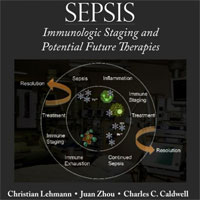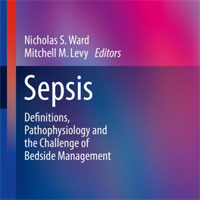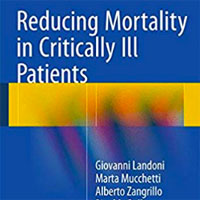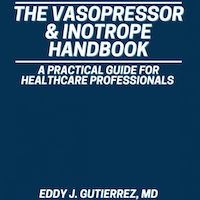Tag: septic shock
Left ventricular systolic function evaluated by strain echocardiography and relationship with mortality in patients with severe sepsis or septic shock
Worse global longitudinal strain (GLS) (less negative) values are associated with higher mortality in patients with severe sepsis or septic shock, while such association is not valid for left ventricular ejection fraction... read more
Pooled Analysis of Higher vs Lower Blood Pressure Targets for Vasopressor Therapy Septic and Vasodilatory Shock
Targeting higher blood pressure targets may increase mortality in patients who have been treated with vasopressors for more than 6h. Lower blood pressure targets were not associated with patient‑important adverse events... read more
New Guidelines for Hospital-acquired Pneumonia/Ventilator-associated Pneumonia
American and European guidelines have many areas of common agreement such as limiting antibiotic duration. Both guidelines were in favor of a close clinical assessment. Neither recommended a regular use of biomarkers but... read more
Effect of a Resuscitation Strategy Targeting Peripheral Perfusion Status vs Serum Lactate Levels on 28-Day Mortality Among Patients With Septic Shock
Among patients with septic shock, a resuscitation strategy targeting normalization of capillary refill time, compared with a strategy targeting serum lactate levels, did not reduce all-cause 28-day mortality. Among 424 patients... read more
Should We Stop Trending Lactate in Septic Shock?
There may be a tendency to cement guideline recommendations into our collective minds as inalienable and sacrosanct – as if carved onto stone tablets and brought down to us from the heights of Mount Sinai. Thoughtful medicine,... read more
Antibiotic timing in Severe Sepsis
Severe sepsis is a time dependent condition and this study builds on previous literature which supports that early identification and treatment of sepsis with antibiotics decreases mortality. Retrospective analysis of a large... read more
Optimizing Hemodynamic Support in Severe Sepsis and Septic Shock, An Issue of Critical Care Clinics
Guest Editor Dane Nichols, MD, has assembled a panel of experts focusing on Hemodynamic Support in Septic Shock. Topics include: Oxygen Delivery and Consumption: A Macro-Circulatory Perspective; Mean Arterial Pressure: Therapeutic... read more
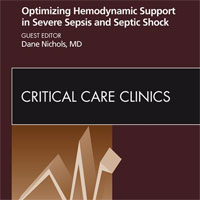
Antifungal Treatment in the ICU
Invasive fungal infections (IFIs) are a major cause of morbidity and mortality in critically ill patients. Almost 80% of IFIs are due to Candida spp., which are the third most common isolated microorganisms in the intensive... read more
Mimics of Sepsis: What do ED Physicians Need to Know?
SIRS and sepsis are common clinical entities. A wide range of estimates for prevalence exists, with 300 to 1000 cases per 100,000 persons per year. Once a septic patient is admitted, more than half will require at least step... read more
Metabolic Sepsis Resuscitation
There are roughly two strategies for adjusting the intensity of treatment: Titrated strategy: Treatment intensity is adjusted to match the severity of the disease. Escalation-deescalation strategy: Treatment intensity is... read more
Antibiotics for the Critically Ill Patient
We spend a lot of time obsessing over the finer details of critical care: which fluid is best? which vasopressor is best? will another liter of fluid help? These details are important, but for a septic patient something... read more
Sepsis Incidence and Mortality are Underestimated in Australian ICU Administrative Data
When compared with the reference standard — prospective clinical diagnosis — ANZICS CORE database criteria significantly underestimate the incidence of sepsis and overestimate the incidence of septic shock, and also result... read more
Effect of Thiamine Administration on Lactate Clearance and Mortality in Patients With Septic Shock
Thiamine administration within 24 hours of admission in patients presenting with septic shock was associated with improved lactate clearance and a reduction in 28-day mortality compared with matched controls. Patients who... read more
Norepinephrine in Septic Shock
Norepinephrine (NE) is both an alpha1- and beta1-agonist, and is therefore able to increase vascular tone and contractility. Recent guidelines recommend NE as the first-line vasopressor in septic shock. However, because septic... read more
Terlipressin vs. Norepinephrine As Infusion in Patients With Septic Shock
In this multicentre, randomised, double‑blinded trial, we observed no difference in mortality between terlipressin and NE infusion in patients with septic shock. Patients in the terlipressin group had a higher number of... read more
Principles of Fluid Management and Stewardship in Septic Shock
There are only four major indications for fluid administration in the critically ill: resuscitation, maintenance, replacement and nutrition (enteral or parenteral). In this review, a conceptual framework is presented looking... read more
Effect of Levocarnitine vs Placebo as an Adjunctive Treatment for Septic Shock
In this dose-finding, phase 2 adaptive randomized trial, patients with septic shock and moderate organ dysfunction were treated early in the course of illness with low (6 g), medium (12 g), or high (18 g) doses of levocarnitine... read more
Long-term outcomes in patients with septic shock transfused at a lower versus a higher haemoglobin threshold
Long-term mortality rates and HRQoL did not differ in patients with septic shock and anaemia who were transfused at a haemoglobin threshold of 7 g/dl versus a threshold of 9 g/dl. We may reject a more than 3 % increased hazard... read more
Septic Shock: Innovative Treatment Options in the Wings
Vitamin C, angiotensin-II, and methylene blue are emerging options on the cutting edge of refractory septic shock treatment that require more investigation, but nevertheless appear promising, Rishi Rattan, MD, said at the... read more
The impact of age on the innate immune response and outcomes after severe sepsis/septic shock in trauma and surgical ICU patients
Aged, critically ill surgical patients have greater organ dysfunction and incidence of adverse clinical outcomes after sepsis. Biomarker profiles suggest an immunophenotype of persistent immunosuppression and catabolism.... read more
Patterns of Early Crystalloid Resuscitation Provided to Sepsis and Septic Shock Patients
Patterns and Outcomes Associated With Timeliness of Initial Crystalloid Resuscitation in a Prospective Sepsis and Septic Shock Cohort. Crystalloid was initiated significantly later with comorbid heart failure and renal failure,... read more
Approach to the Critically Ill Child: Shock
If you mainly treat adults or both adults and children like me, then you have probably heard the (very annoying) quote, "kids are not just small adults", and so I won't say it again. Well, I guess I just did, but at least... read more





